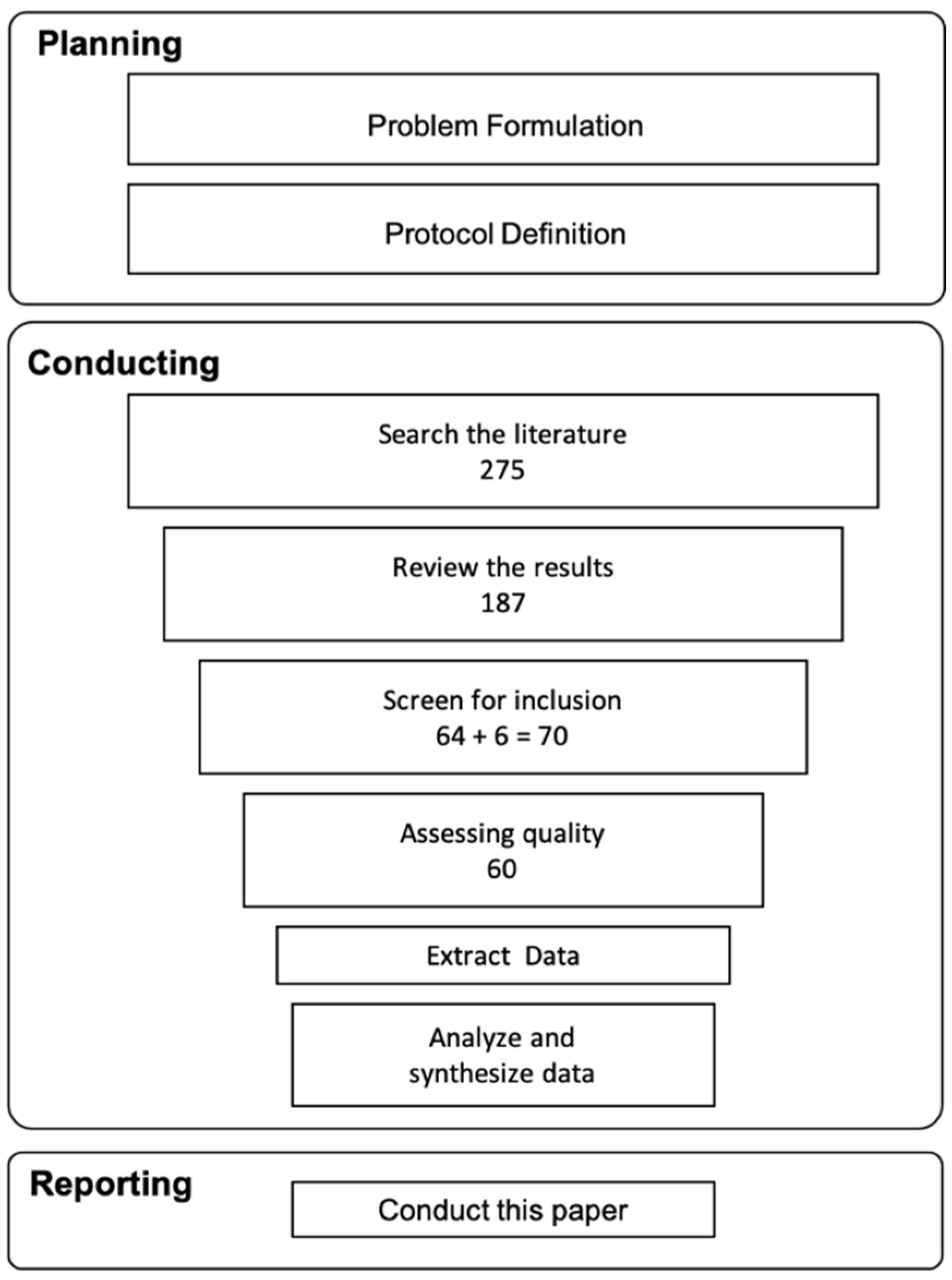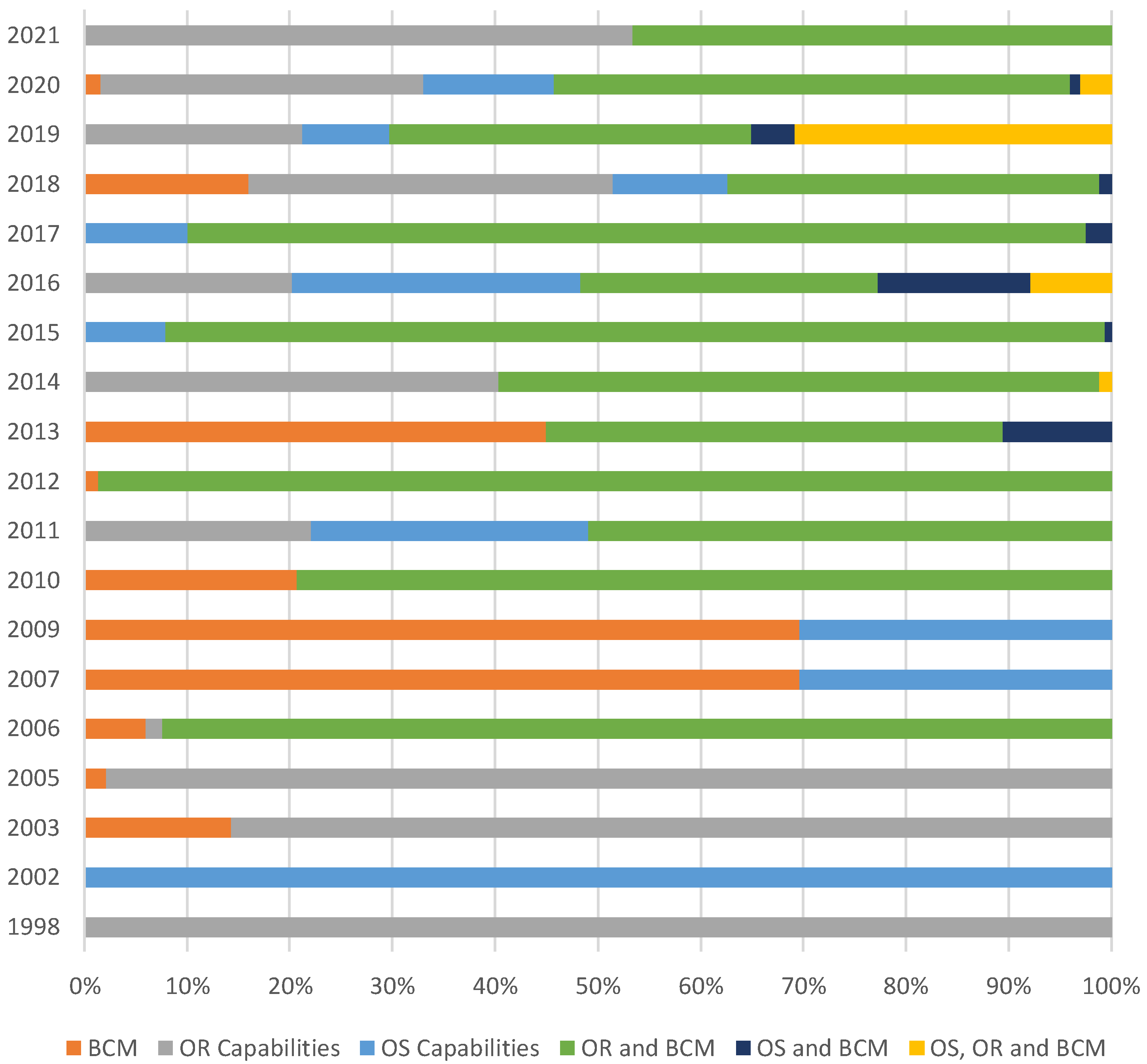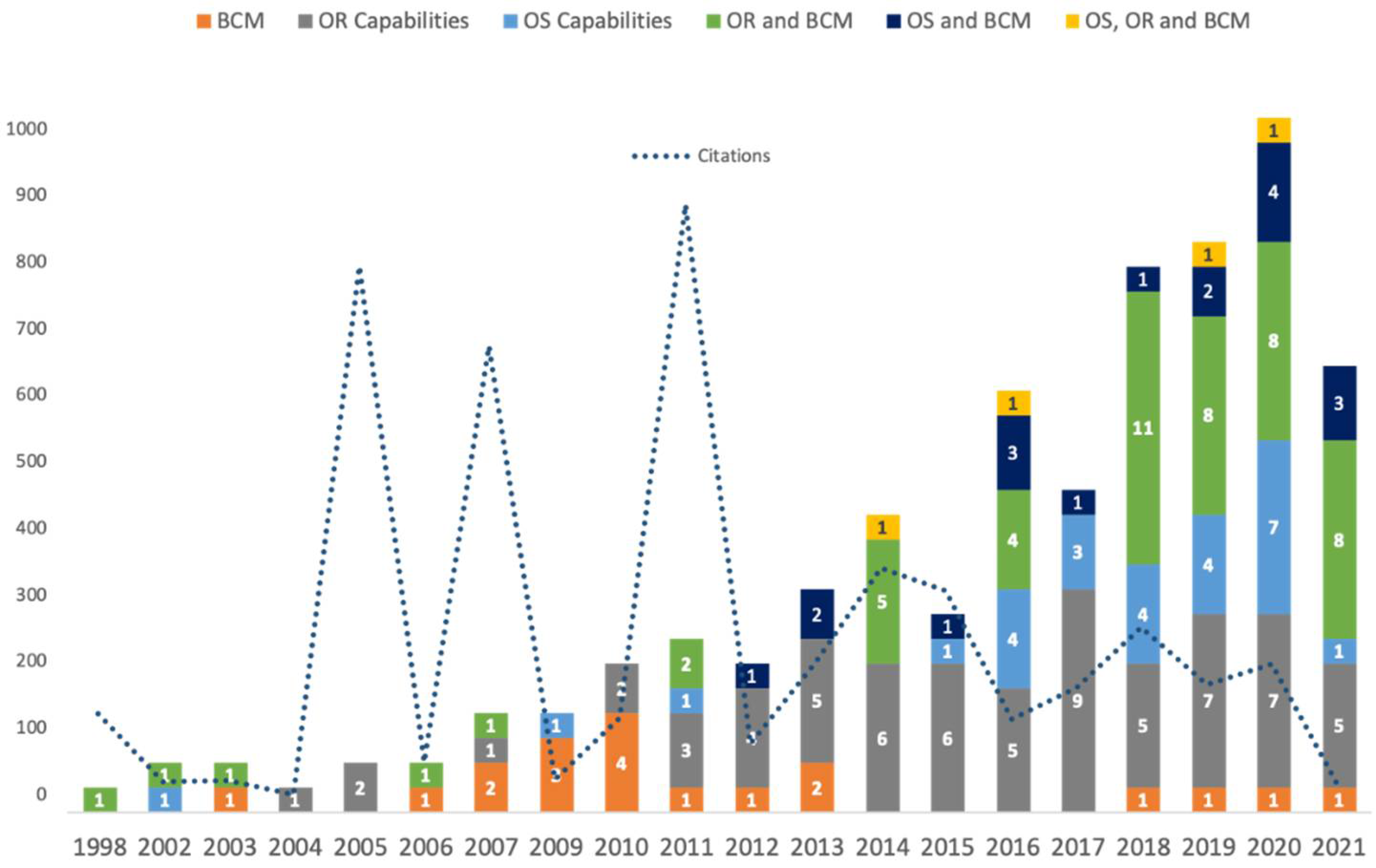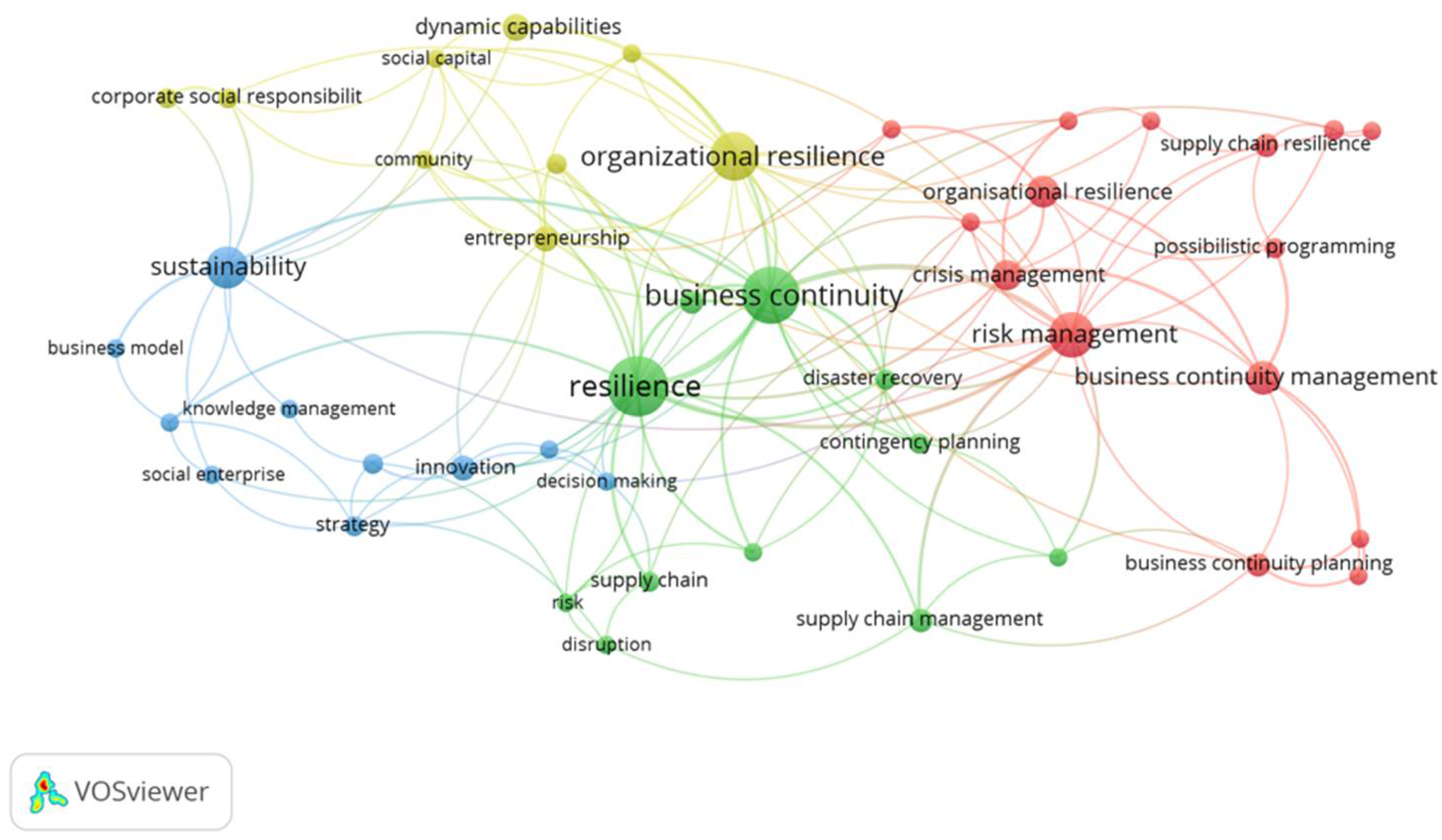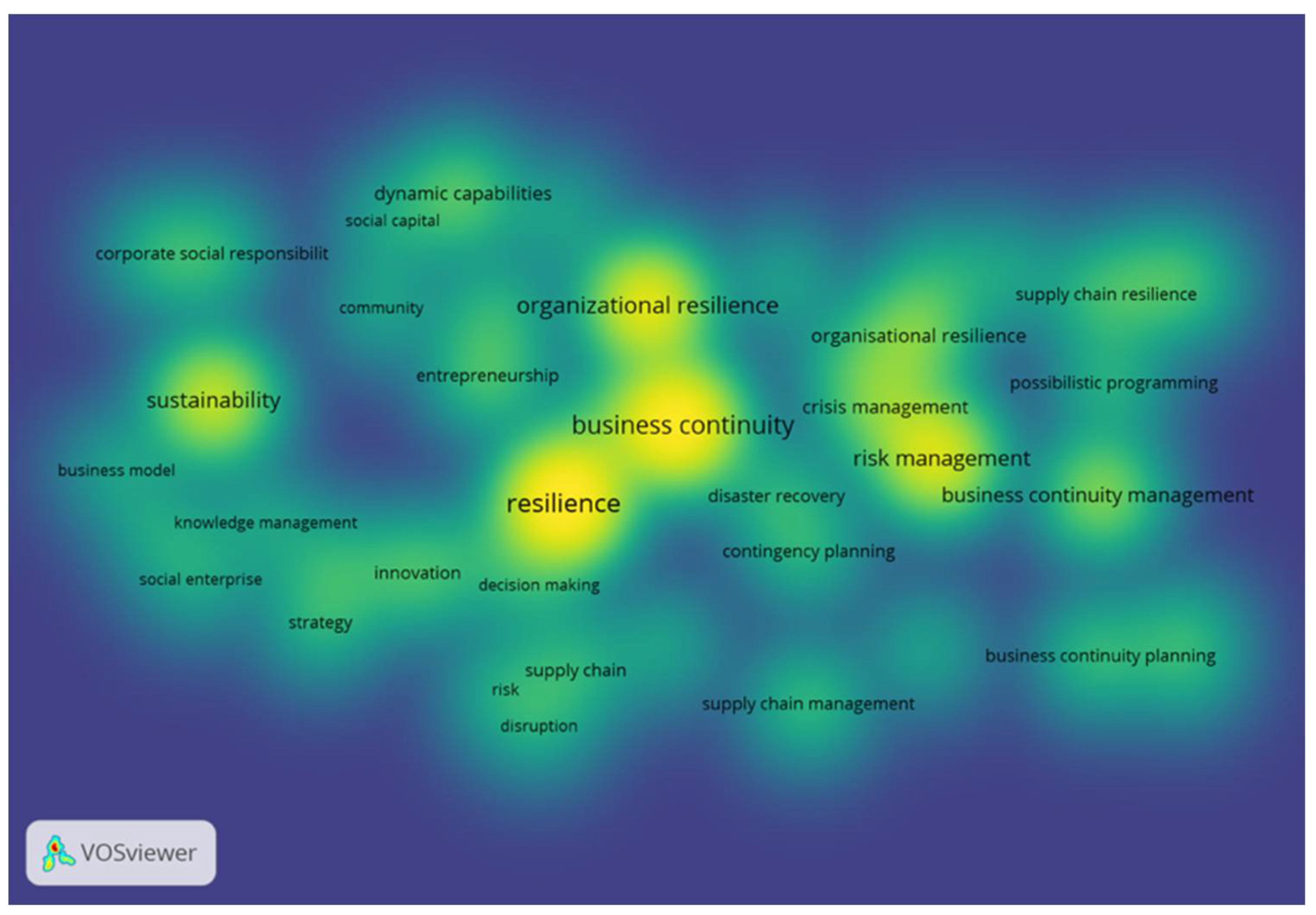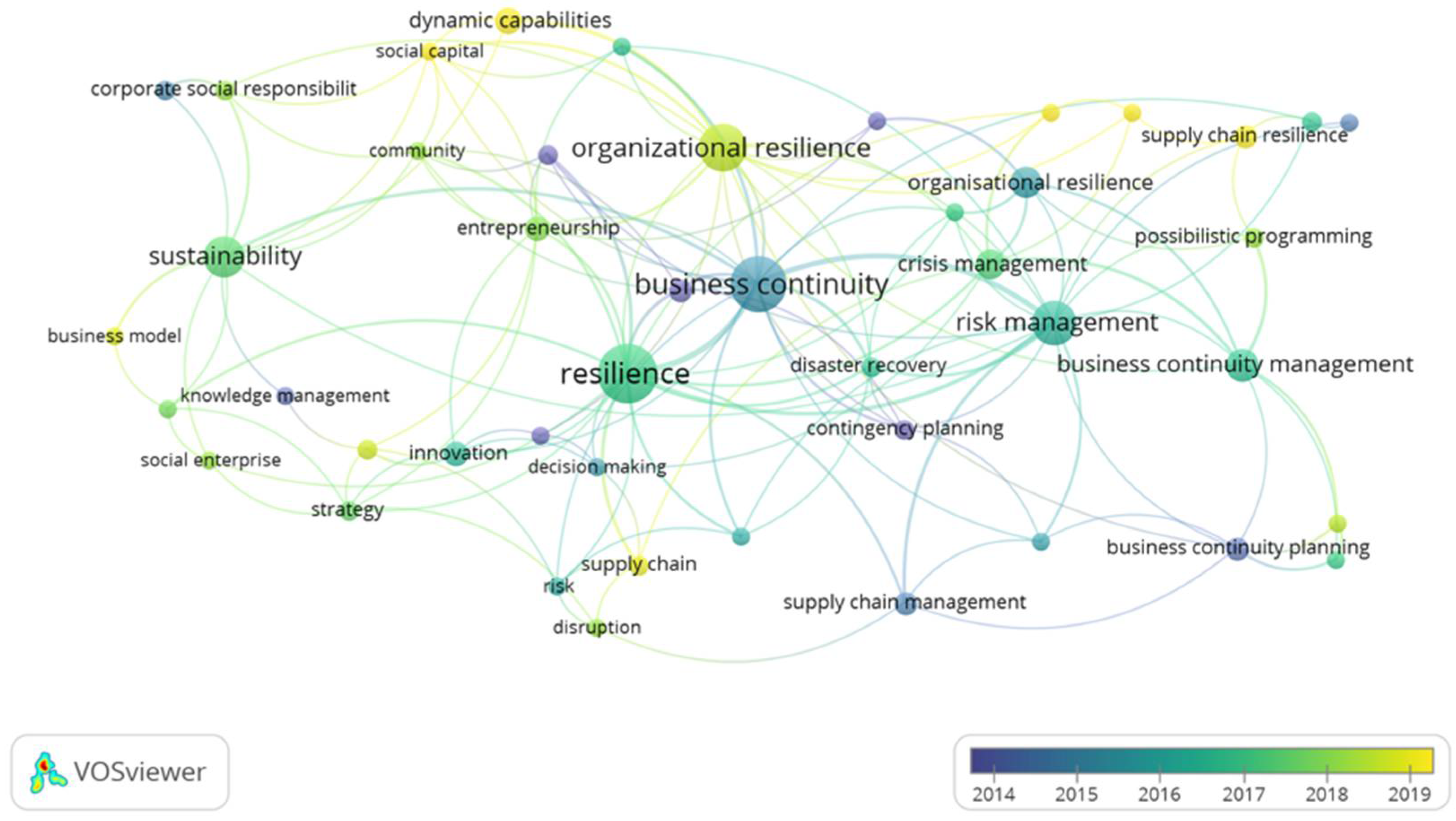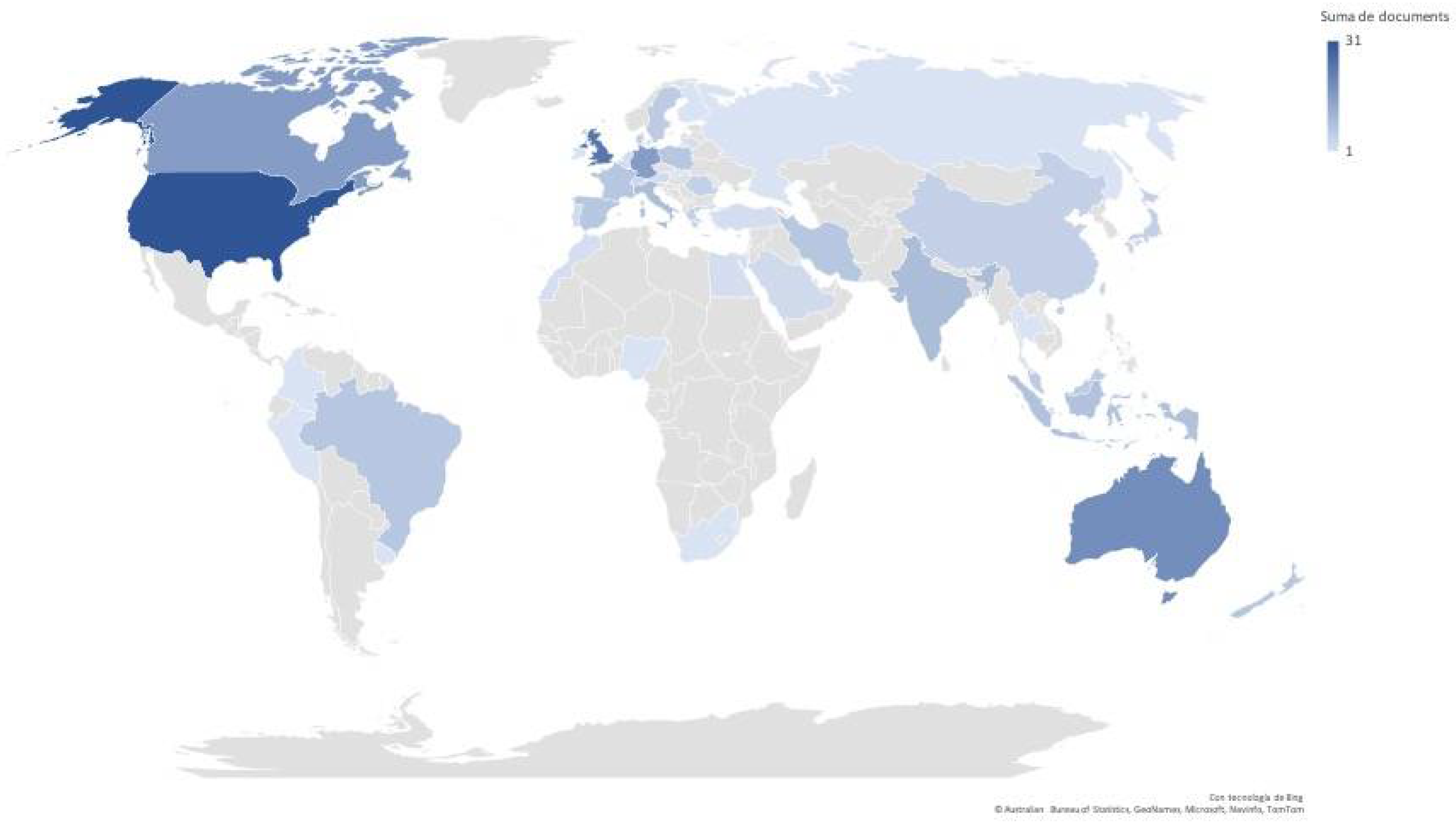1. Introduction
According to the World Economic Situation Report (WESR) 2021 [
1], the COVID-19 pandemic has been identified as a once-in-a-century crisis, in which uncertainty is a constant and difficult choices must be made to protect employment and productivity, exposing systemic vulnerabilities at an economic level. As a result, the role of Sustainable Development Goals [SDG] is highlighted, as safeguards and drivers of resilience for countries, business and communities, in order to develop competencies against future crises. “There is clearly no sustainable development without resilience and there is no resilience without sustainable development. Building economic, social and environmental resilience must guide the recovery from the crisis” [
1].
In 2020, the gross world product fell by approximately 4.3% (developed economies shrunk by 5.6% and developing ones by 2.5%), 2.7 billion workers were affected (about 81% of the world’s workforce), the aggregate unemployment rate in the Organization for Economic Cooperation and Development (OECD) reached 8.8% by April 2020, and fell to 6.9% in November 2020 (unemployment rate record highs: 27% in Nigeria, 23% in India, 21% in Colombia, 17% in the Philippines, and above 13% in Argentina, Brazil, Chile, Saudi Arabia, and Turkey). During the second and third quarters of the year, an average of approximately 420 million full-time equivalent jobs were lost. The number of people living in poverty was expected to increase by 131 million in 2020 alone, representing a poverty headcount ratio of over 9%. International tourism plunged by 70%, with estimated losses of US$ 1.1 trillion (creating an emergency for many developing countries). Global and domestic supply chains shocked out, and global trade in goods and services is estimated to have declined by 7.6%. As a result, the path towards recovery requires a commitment to the SDGs from governments, businesses, and communities, in order to build resilience to future economic, social, and climatic shocks. It is through the development of a firm’s capabilities to respond, absorb, and transform to changing circumstances, that Organizational Resilience [OR] is built and contributes to Organizational Sustainability [OS].
OS can be defined, in terms of time, as a capability for being competitive now and in the future, considering that it has an impact on the Triple Bottom Line [TBL] principles (economic, social, and environmental) [
2] and its perspective has evolved to include ethical and technological aspects [
3]. In addition to this, OS capabilities and OR capabilities are related whenever critical resources and full recovery strategies of organizations are established to recover from disruptions, in order to protect their value propositions [
4].
OR is a multidisciplinary concept studied from psychology, ecology, economics, emergency management, sustainable development, and supply chain risk management [
5,
6]. The concept evolves and has been established as an organizational capability to avoid, absorb, respond to, and recover from situations that may affect its survival [
7], or a meta-capability that articulates other ordinary and dynamic capabilities in their different stages: anticipation, copying, and adaptation [
8]. Findings related to OR capabilities point out anticipation as a capability related to preparation and resource availability, based on ecological, resource-based, and legitimacy theories [
8].
Business Continuity Management [BCM] initiatives are defined to preserve or create value, and an interaction with organizational business models is established by doing so, to improve them and respond to disruptive events [
9]. Recent studies have put forward the organizational capability approach for BCM [
10], explaining why it is critical to develop OR and OS capabilities in order to prepare for, respond to, and recover from disruptive events [
11] and how they promote the implementation of BCM practices.
Nowadays, OS and OR challenges have increased strategic requirements associated with the development of organizational capabilities, especially those required to maintain organizational balanced relationship with the TBL [
12,
13,
14]. The contributions of OS capabilities and OR capabilities to impact BCM is suggested but not explicit, as may be observed in OR [
15,
16,
17,
18,
19,
20] and OS [
21] foundations. Nevertheless, the value of their interaction has been established ever since interest in OR emerged, especially in the field of supply chain management [
4,
22,
23,
24]. Clarifications about OR called the attention of researchers and practitioners [
5] associated with organizational preparedness [
25], community resilience [
17,
26], and resilience process systems involving Business Continuity [BC] and OS approaches [
27].
The relationship between OS capabilities and OR capabilities has been studied through organizational awareness and decision-making for global challenges and uncertainty. Frameworks to understand how these capabilities interact and contribute to Sustainable Development [SD] have been identified [
28]. Nevertheless, the interaction between OS capabilities and OR capabilities, to impact BCM, has not been sufficiently studied, although it has gained interest in recent years [
4,
23,
27,
29]. Consequently, there is still a wide field of research to be explored, ranging from the determination of OS capabilities and OR capabilities [
30,
31] to the validation of existing frameworks in different types of sectors [
32], organizations such as SMEs [
33], and developing countries [
34,
35].
In this paper, we identify relationships between OS and OR and how they impact BCM, as well as highlight future lines of research. We used Bibliometric Analysis to identify how the body of knowledge has evolved. Moreover, we used a Systematic Literature Review [
36] to identify organizational capabilities that develop OS, OR, and BCM. This literature review focuses on: (1) relationships between OS capabilities and OR capabilities, (2) findings in the literature that draw relationships between BCM and organizational capabilities, and (3) the main contributions for understanding relationships between OS capabilities and OR capabilities to impact BCM.
As a result of the literature review, there is no evidence of articles that have studied the relationship between OS capabilities and OR capabilities and BCM from bibliometric analysis and systematic literature review methodology perspectives. Our main contributions are the following: (1) to describe what is being said about the relationship between OS capabilities and OR capabilities, which impact BCM, from 1998 to 13 May 2021; (2) the main papers, countries, journals, and authors for the above constructors, through bibliometric analysis, using VOSviewer software, and papers found in the Web of Science and Scopus databases; (3) to propose cluster analyses to identify relationships and trends in the body of knowledge using Bibliometric Analysis and VOSviewer software; (4) content analysis from the selected papers according to their relevance on the matter using Systematic Literature Review; (5) to provide insights about OS, OR, and BCM relationships for researchers and practitioners, in order to expand the body of knowledge and improve their practice, respectively.
This paper is organized as follows: the next
Section 2 presents the description of the methodology used for this literature review, followed by
Section 3 where the main findings for OS, OR, and BCM and their relationship are presented. Subsequently,
Section 4 presents the results of the literature review; the last
Section 5 finishes the paper with the conclusions of this study and opportunities for further research.
4. Results
The body of knowledge on OS, OR, and BCM behavior has increased constantly every year since 2018. That is the main reason we conducted this literature review using two methodological perspectives. On one hand, we have systematic literature review analysis, which allows researchers to synthesize and to verify hypotheses, and thus evaluate a body of knowledge from a desirable area [
36]. On the other hand, we implement bibliometric analysis because it is widely used in SD research, enabling the identification of tendencies and leading journals, authors, and regions, followed by the opportunity to identify research directions and cooperation [
37]. This section presents the results of both methodologies.
4.1. Most Cited Papers Analyses
Back in 1998, Mallak established the importance of managers using tools and frameworks that involve principles related to resilience, including a personnel and organizational level [
44]. Sheffy and Rice subsequently associated the flexibility of the essential elements of the supply chain with increasing OR [
22]. They proposed that building a resilient enterprise requires a strategic initiative that involves risk management and business continuity to increase companies’ competitiveness [
22]. Along that line, Craighead et al. established the need to incorporate mitigation capabilities (warning and recovery) in order to guarantee supply chain business continuity [
24].
Consequently, Bhamra et al. noticed the importance of identifying organizational susceptibilities to disruptions in order to define OR capabilities and BCM response [
5]. Paulraj proposed that sustainable supply management and sustainable practices that involve organizational suppliers and clients contribute to OS and OR [
50]. This is aligned with the proposal of Ates et al. for developing change management capabilities in SMEs to support OS and OR [
58].
A couple of years later, Chopra and Sodhi found that strategies for reducing supply chain fragility (segmenting and regionalization) are related to disruptive risk using business continuity plans [
72]. In addition to this, Sahebjamnia et al. proposed a framework integrating business continuity and disaster recovery practices to increase organizational performance during disruptive events to enhance OR [
19]. In addition, Torabi et al. proposed a resource allocation model for a pre-event and post-event phase to increase OR [
73].
Table 2 presents the 10 Most Cited Papers and their contributions to the body of knowledge. Papers are organized by total citations.
Figure 2 shows the evolution of OS capabilities, OR Capabilities, and BCM Average Citation Body of Knowledge by total citations. The numbers were normalized to provide a perspective on the distribution of citations from an average perspective.
The citation behaviors show us the interest of the scientific community in OS capabilities and OR capabilities and their relationship to BCM. The results show that the emphasis on the interaction between OS, OR, and BCM (yellow) increased from 2015, and that contributions to that interaction, between wide concepts of sustainability and resilience with BCM, could be valuable for researchers and practitioners. OR capabilities (grey) have been in organizational agendas since 1998, but it was not until 2018 that they have gained sustained interest.
The most cited papers show us that interest is growing, and contributions from empirical research will be useful. Moreover, the relationship between OR and BCM (green) calls for attention as of 2007, and has been maintained from 2009 until nowadays. This relationship is supported in supply chain management, and SMEs need to enhance organizational performance for high-uncertainty environments. Nonetheless, the OS and BCM (dark blue) relationship appears in 2013 and stands annually from 2015, supported by the organizational need to preserve environmental, societal, and economic performance, during disruptive events, through stakeholder interaction.
The starting point of interest in OS capabilities (light blue) is 2002, but it is not until 2015 that they remain, consequently, with OS and BCM analysis. Finally, BCM concept relation with capabilities shows a flashing interest, which appeared in 2003, and increasing interest is evident in 2021, with a strong presence in the body of knowledge, allowing us to conclude that contributions to this area can enhance organizational performance during disruptive events, particularly when a relationship with OS capabilities and OR capabilities is established. Finally, the relationship between OS capabilities and OR capabilities with BCM is observed for the first time in 2014, from a supply chain risk management perspective [
23], reappearing in 2016, proposing an incident sequence approach [
29]. After that, it appeared again in 2019 for supply chain management resilience, and, in 2020, was associated with the evolution of Process System Resilience (PSR) [
4].
4.2. Annual Papers and Distribution of Citations
Citations started in 1998 with the relationship between OR and organizational capabilities. From that moment, principles and disciplines related with OR capabilities have been established as the need for individuals, as decision-making actors, that can influence organizational performance during a crisis [
44]. After seven years, through an MIT paper in 2005 with 780 citations, the most cited paper in this body of knowledge, an explicit relationship was established between OR and BCM from a process management perspective [
22].
Later on, the relationship between OR and BCM stands out through warning and recovery capabilities, categorized as mitigation capabilities, for a supply chain management perspective [
24], motivated by legislation and standardization processes related to the adoption of BCM practices [
67]. In addition to this, the relationship between OR and BCM is identified through dynamic capabilities, such as change management for adaptation purpose [
56]. Finally, Hillman clarifies the academic disciplines related to OR, and the relationship with business continuity appears in foundational case studies that cover resilience from a survivability, resumption, and restoration perspective. Business continuity is seen as a source or metric for resilience, and the BCM system is seen as part of the integrated resilience management system [
55].
Similarly, the starting point of the relationship between OS and BCM involves a sustainable supply chain approach, pointing out relational capabilities as a catalyzer when a response that involves stakeholders is needed and a solid link with them is required [
50].
Following that approach, the relationship of OS and OR with BCM had a starting point in 2014, looking for a way to strength supply chain risk management for business continuity using a case study methodology [
23], and was defined in 2016 using two different approaches. First, a firm-centric or a community-centric posture was used from a community resilience perspective [
17]. Second, an incident resilience planning framework approach was used, incorporating time-performance phases: (1) Reaction (Minimum operational capability), (2) response (Minimum sustainable capability), and (3) restoration (Learning and adaptive capabilities).
Once the relationship between OS and BCM was established, the role of top management was studied and comes out as particularly important for the adoption of practices, pointing out that leadership is the main internal driver of OS [
74]. It was found that the OS interpretation of managers is associated with adaptability and continuity practices because they contribute to maintaining economic, social, and environmental performance [
74].
Figure 3 summarizes annual papers and citations and shows how the relationship between research concepts evolves.
The growth of publications is not constant, and stationarity can be identified in years such as 2011 [
5], with a notorious interest in the OR and BCM interaction. Nonetheless, in 2014, interest in OR Capabilities [
31,
59] and their relationship with BCM [
72] was distributed equally, and the OS, OR, and BCM interaction appeared for the first time [
75]. Subsequently, in 2016, interest was stirred up [
29], and it was only until 2019 that has been retained.
4.3. Cluster Analysis
One of the primary advantages of bibliometric analysis is mapping the co-occurrence of concepts in the body of knowledge. This co-occurrence analysis using authors’ keywords and the full counting method enables researchers to improve their capacity to understand results. For this paper, “3” occurrence of words was selected in order to have a broader vision of the field of research [
76], and of the 612 keywords, 45 met the established threshold. After this, no significant keywords were removed from the analysis. As a result, four dominant clusters were identified.
Figure 4 shows the relationship between these clusters.
As presented in
Figure 4, correlations between OS, OR, and BCM are established, but not with a strong correlation. Additionally, the corresponding colors of the clusters in
Figure 4 are red (first cluster), green (second cluster), blue (third cluster), and yellow (fourth cluster). It is interesting that the word “Organizational Sustainability”, having been such as important concept, does not appear in the 45 keywords that meet the criteria of 3 co-occurrence authors’ keywords. This is because we are interested in OS Capabilities concept, and in the body of knowledge, this concept appears in 2002, 2009, 2011 [
50], and it is finally, in 2015, that the interest in this concept remains until nowadays, as it is shown in
Figure 3. Cluster analyses draw lines of research that are presented in
Section 5.
4.3.1. First Cluster (Red): From Risk Management to Business Continuity Management and Organizational Resilience
The first cluster has 15 concepts related to “Risk Management,” “Business Continuity Management” and “Organizational Resilience.” We named this cluster
From Risk Management to Business Continuity Management and Organizational Resilience. In this cluster, the concept of risk management is associated with OR capabilities through resource management, emergency and crisis management, and for disruptions with business continuity and disaster recovery management [
77]. Additionally, BCM is presented as a firm’s enabler, for effective responses to business disruptions [
19], that contributes to OR [
69] and to OS [
78].
Table 3 shows First Cluster keywords, occurrences, and link strength.
This cluster shows the evolution from a risk management approach that introduces awareness capabilities into organizational culture, calling for a response to disruption events using BCM practices, especially for supply chain management [
24]. It is interesting how the role of crisis management emerges in this cluster as a mediator between BCM and OR [
67,
79]. This cluster trend is related to supply chain resilience [
72], using possibilistic programing [
80] for supply chain disruptions, such as COVID-19, and enhancing organizational learning capabilities [
69].
4.3.2. Second Cluster: Resilience and Business Continuity Practices
The second cluster (Green) has 11 concepts surrounding “Resilience” and “Business Continuity.” We named this cluster
Resilience and Business Continuity Practices, meaning the cluster emphasis is on the relationship between resilience and business continuity through organizational practices, how they interact with supply chain management [
4], contingency planning [
30], disruptions [
24], and when these elements are in place, how the relationship with OR frequently appears [
19,
81].
Table 4 shows the Second Cluster keywords, occurrences, and link strength.
This cluster shows the evolution from a business continuity approach, using disaster and contingency planning practices [
30], for building resilience [
5], and its relationship with social capital development in order to enhance OR and BCM, especially in SMEs [
33].
4.3.3. Third Cluster: Business Continuity Contribution to Innovation and Sustainability
For the third cluster (Blue) analysis, “Sustainability” and “Innovation” emerge with 10 concepts surrounding them. We named this cluster
Business Continuity contribution to Innovation and Sustainability, taking into account that business continuity strategies stimulate innovation and, at the same time, preserve sustainability [
27,
32]. Additionally, this cluster reveals organizational needs for management practices aligned with an organizational strategy to support sustainability [
50] and how they lead to innovation [
62,
82]. Moreover, knowledge management [
34] and business model awareness [
61] are related to the sustainable performance of firms [
32].
Table 5 shows Third Cluster keywords, occurrences, and link strength.
This cluster shows the evolution from organizational and entrepreneur Corporate Social Responsibility [CSR] practices [
83] to sustainability practices [
61]. Particularly, it is identified that sustainability practices lead to dynamic capabilities [
62] and social capital development [
84].
4.3.4. Four Cluster: Dynamic Capabilities for Organizational Sustainability and Organizational Resilience to Enhance Business Continuity Management
Finally, the fourth cluster (Yellow) involves “Organizational Resilience”, “Dynamic Capabilities”, and “Entrepreneurship.” We named this cluster
Dynamic Capabilities for Organizational Sustainability and Organizational Resilience to enhance Business Continuity Management. This result links entrepreneurship [
33], social capital [
48], community [
17,
26], and CSR [
74] with the fact that OR requires dynamic capabilities [
35] when adaptation is the expected outcome of OR [
31]. These dynamic capabilities are related with OS [
32] and BCM through OR [
8].
Table 6 shows Fourth Cluster keywords, occurrences, and link strength.
This cluster shows the evolution from business continuity, resilience, and CSR practices to OR developing dynamic capabilities [
64,
85]. It especially emphasizes the interaction between OR and sustainability through dynamic capabilities [
35] and social capital development [
48].
4.4. Cluster Density and Overlay Visualization
Intertwining between concepts is shown using density visualization. In
Figure 5, the heat map reveals how keywords interact and concentrate, highlighting “Resilience”, “Business Continuity”, “Organizational Resilience”, “Sustainability”, and “Risk Management.” This is interesting because the role of risk management in business continuity, OR, and sustainability remains, even though this concept is not used in any of the search equations. As Herbane mentioned [
67], the relationship of risk management with BCM and OR is linked to crisis management [
86]. In addition, its relationship with OS comes from the business continuity and supply chain management perspective [
72].
Figure 5 presents cluster density co-occurrence.
The evolution of the body of knowledge can be seen in
Figure 6. From 2014 to 2019, as the threshold was set for a minimum of 3 co-occurrences of authors keywords, looking to understand OS capabilities and OR capabilities relationships with BCM, papers began meeting that criterion in 2014, the paper published that year discussed the importance of implementing supply chain risk management practices to respond to business continuity events, and at the same time, what is the importance of full collaboration, through supply network partners, to secure the supply chain [
23].
The evolution of the relationship between OS, OR, and BCM, looking to understand the relationship between OS capabilities and OR capabilities with BCM, appeared between 2016 and 2018. This relationship was built around resilience, sustainability, and risk management. The relationship between OR and BCM was established through risk management and sustainability through business continuity practices. As may be seen in
Figure 6, future lines of research are associated with dynamic capabilities, supply chain resilience, social capital, and organizational response to disruptive events (yellow spots that represent thresholds of authors’ keywords).
4.5. Main Countries and Journals
Bibliometric analysis and systematic literature review methodologies seek to achieve a knowledge and understanding of the field of research, and by doing so, scholars and practitioners made decisions about their research interests. The top 10 Countries reveal that, of total papers, the United States, United Kingdom, and Germany represent 34% of the total contribution for the body of knowledge. The most cited paper from each country, with its corresponding search equation, are related to identify which concepts are more relevant. For each country, we sought Country Classification [CC] using the United Nations World Economic Situation Prospect for 2021 [
1], looking for trends in developed and developing countries.
Table 7 shows the results.
The Most Cited Papers from the United States, United Kingdom, and Iran are included in
Table 2, which shows the 10 Most Cited papers in this body of knowledge. Paper titles show the interest in the relationship between supply chain management and OR for developed countries, and OS from developing ones. From a search equation perspective, something interesting comes up when the CC is considered. First, the most cited papers in developed countries are related to OR and BCM (71%), BCM (14%), and OR capabilities (14%). This shows how the OR and BCM relationship is in countries’ agendas, and a capability approach is established. Second, the most cited papers in developing countries, corresponding to the search equation, are distributed between OR and BCM [
5,
17,
22,
73,
87,
88], OS and BCM [
89], and OS Capabilities [
90], which shows an interest in understanding the relationship between OS capabilities and OR capabilities with BCM. These observations contribute to future lines of research, which involves developing countries, using descriptive and empirical studies, related to the interaction between OS capabilities and OR capabilities with BCM, to enhance firms’ performance during disruptive events.
Figure 7 shows BKC per Country by Number of Papers. As may be seen, even though the participation of developing countries is 46%, its total average of papers is very low compared to developed countries. This is interesting because future lines of research can lead to increasing the contributions of developing countries’ experiences to this body of knowledge.
The Top 10 Journals are organized by their total paper contribution and total citation, which ranks the International Journal of Production Research in first place. The most cited paper from this journal points out the importance of clarifying the concept of resilience, its gaps and research opportunities [
5], and is included in this research as the Third-most cited paper. It is important to highlight that the CiteScore Percentile was obtained from the Scopus database, except for the International Journal of Entrepreneurial Behavior & Research CiteScore Percentile, which was not found in Scopus, and was obtained using the InCite Journal Citation Report from the Web of Science database. The Ad-Minister Journal CiteScore Percentile was not found in either of the two databases used for this research.
Table 8 shows the results.
As it can be seen, Journals’ most cited papers contribute to OR understanding and development and elaborate around its relationship with risk management and BCM. This result is consistent with this research’s First Cluster analysis and presents a future research line associated with OS capabilities and OR capabilities relationship with BCM and its impact on firm’s performance.
It is important to mention that, even though the most cited paper from this research is from MIT Sloan Management Review, this Journal contributes with 2 papers in this research’s body of knowledge. For this Top 10 Journal analysis, total paper contribution was prioritized.
4.6. Main Contributions to Concept Relationships
4.6.1. Evolution of the Body of Knowledge of OS Capabilities
OS capabilities respond to a sustainable supply management need (2011) and a business model requirement to survive (2016). This evolution presents strategic (cost efficiency and business model) and knowledge management approaches. Both contribute to organizational learning from past events (2018) in order to increase OS capabilities and maintain competitive advantage, as well as preserve the balance with the TBL (2019). For this analysis, search equation results from OS capabilities were used.
Table 9 shows the Evolution of the Body of Knowledge of OS capabilities.
The OS capabilities concept contributes 14% of the papers and 9% of the total citations in this body of knowledge. In order to understand the OS capabilities relationship with BCM, search equation results associated with OS and BCM, as well as OS, OR, and BCM, were used. The future OS capabilities lines of research consider empirical and academic approaches. The determination, examination, and validation of these capabilities at the organizational level should be explored for SD contributions.
4.6.2. Evolution of the Body of Knowledge of OR Capabilities
OR capabilities are associated with the organizational response to uncertainty (1998), Sustainable Business Excellence, and strategic response (2003 and 2006). This conversation evolved into dynamic capabilities and SMEs arenas in 2011, looking for a response to turbulent environments and extreme events. It is interesting to see how system dynamics appeared after a strategic and performance approach, looking to establish an operational foundation for OR capabilities that involves individual and organizational levels (2004). From 2016, specific OR capabilities began to be identified as contributing to OR, mainly from process management practices, according to the resilience process stages (2016 to 2021). Search equation results from OR capabilities were used for this analysis.
Table 10 shows the Evolution of the Body of Knowledge of OR capabilities.
The OR capabilities concept contributes 27% of the papers and 17% of the total citations in this body of knowledge. In order to understand the OR capabilities relationship with BCM, search equations results associated with OR and BCM, as well as OS, OR, and BCM, were used. Future lines of research are oriented to validate existing frameworks and capabilities at an empirical level, in different sectors/industries, organizations such as SMEs, and developing countries.
4.6.3. OS Capabilities and OR Capabilities to Impact the Evolution of the Body of Knowledge of BCM
OS capabilities and OR capabilities that impact BCM are associated with business supply chain risk management (2014), followed by an incident management sequence approach that covers capabilities for the restoration phase (2016). This conversation evolved into a suggested framework for vulnerabilities and capabilities to protect firms’ profits in 2019. Finally, in 2020, a systems-based resilience approach that contributes to BCM was introduced.
Table 11 shows OS capabilities and OR capabilities to impact the Evolution of the Body of Knowledge of BCM.
OS, OR, and BCM concepts contribute 3% of the papers and 1% of the total citations in this body of knowledge. Search equation results from OS, OR, and BCM were used for this analysis. Research lines for these concepts are oriented to determine how OS capabilities and OR capabilities interact to impact BCM, using existing frameworks as a reference, and evaluating performance in different sectors and organizations such as SMEs in developing countries.
5. Conclusions and Future Lines of Research
This paper aims to present findings for bibliometric analysis and systematic literature review methodologies for OS capabilities and OR capabilities to impact BCM. This section offers conclusions and limitations, as well as future research agenda. This literature review may benefit the scientific community for future studies, and practitioners for incorporating practices, when BCM must be aligned with OS capabilities and OR capabilities.
5.1. Conclusions
This paper maps research for the relationship between OS capabilities and OR capabilities with BCM using the Scopus and Web of Science database for the analysis, with a period covering all the years up to 13 May 2021. As a result, 275 documents were found and used for bibliometric analysis and systematic literature review purposes. Papers were classified according to search equation results, with the corresponding concept as follows: OS Capabilities; OR Capabilities; OS and BCM; OR and BCM; OS, OR and BCM; BCM.
For the bibliometric analysis methodology, 612 keywords were identified, and 45 met the threshold criteria (co-occurrence of 3 authors’ keywords). These were used to create clusters. The VOSViewer software was used for cluster analysis, as well as for institutions and the main contributions of countries.
For the systematic literature review methodology, 60 papers were selected, content analysis was applied, and the relationship between the concepts was established. Its results were used for a deeper understanding of bibliometric analysis results.
A chronological analysis showed us that the starting point for this Body of knowledge analysis was 1998. Nevertheless, it was only in 2017 that a constant growth of papers could be seen (2017 = 13; 2018 = 22; 2019 = 23; 2020 = 28; 2021 = 18). This behavior shows how relevant the research is for these concepts’ interaction to respond to highly uncertainty environments. As may be seen in 2021, the organizational response to COVID-19 was researched from a descriptive and explicative perspective, looking for insights that can contribute to organizational performance [
48,
92,
93,
94,
95].
The most cited papers for this research present a growing interest in the relationship between OR and BCM [
5,
19,
22,
24,
72,
73] and the development of OR Capabilities [
44,
72] and OS Capabilities [
50]. A citation analysis revealed how OR capabilities have been in organizational agendas from 1998, but it was not until 2007 that its relationship with BCM (OR and BCM) appeared, contributing to supply chain management and SMEs’ needs to enhance organizational performance for high-uncertainty environments. Similarly, interest in OS capabilities began in 2002 and reappeared in 2015, with a growing interest in contributing to organizational performance, maintaining TBL balance. Likewise, BCM relationship with capabilities shows a flashing interest, appearing in 2003 and reappearing in 2021, with a strong presence in the body of knowledge. The relationship between OS and BCM appeared in 2013 and, from 2015, the interest in this relationship remains until nowadays, supported in the organizational need to preserve environmental, societal, and economic performance during disruptive events through stakeholder interaction. Finally, the relationship between OS, OR, and BCM is observed for the first time in 2014, associated with supply chain management requirements, and in 2016 with an incident sequence approach for resilience planning. It reappeared in 2019 with the same interest in supply chain management from a resilience perspective and associated with the evolution of process system resilience in 2020. These concepts’ interaction from a citation perspective shows a growing interest in how the development of OS capabilities and OR capabilities is required to respond to disruptive events, and how their contribution to BCM requires a deeper understanding to enhance firms’ performance.
The cluster analysis provided 4 clusters. The first cluster,
From Risk Management to Business Continuity Management and Organizational Resilience, shows the evolution from a risk management perspective, setting organizational roots for awareness capabilities, followed by a BCM approach to develop response and recovery capabilities for disruptive events, and leading to OR capabilities for anticipation, coping, and transformation stages in the resilience process, building a meta-capacity. The second cluster,
Resilience and Business Continuity Practices, involves disaster and contingency planning practices to enhance organizational responses, especially on SMEs response to disruptions using existing frameworks that contribute to OR. The third cluster,
Business Continuity contribution to Innovation and Sustainability, proposes highlighting the role of BCM as an organizational value preserver (OS) or creator (innovation) through strategic management and organizational practices, when an interaction with the business model is required. The fourth cluster,
Dynamic Capabilities for Organizational Sustainability and Organizational Resilience to enhance Business Continuity Management, associate entrepreneurship, social capital, community and CSR with dynamic capabilities, and their contribution to firms’ performance in high-uncertainty environments. Dynamic Capabilities for OS and OR are established as a desirable organizational resource. Four cluster analyses presented the relevance of concept interaction research, which will contribute to the understanding of the relationship between OS capabilities and OR capabilities with BCM, and how this relationship contributes to organizational performance by determining OS capabilities and OR capabilities that are identified, but not associated with BCM, responding to research calls from authors that have pointed out the importance of these interactions [
23,
25,
26,
80,
82,
88].
The cluster density analysis showed the role of risk management in the foundations of the OS, OR, and BCM relationship. It remains an important constructor even though this concept is not used in any of the search equations. Additionally, cluster overlay visualization shows the chronological evolution of the relationship between OS, OR, and BCM, with risk management as a catalyst for BCM and intermediary between BCM and resilience. Finally, the relationship between BCM and sustainability was established through business continuity practices. This density behavior shows how the interaction between OS, OR, and BCM is gaining relevance, highlighting the relation between these concepts with OS capabilities, OR capabilities, and BCM. Emerging lines of research that contribute to identifying the interactions between OS capabilities and OR capabilities with BCM should involve a supply chain resilience, dynamic capabilities, and innovation approach.
The main countries and journals for this research body of knowledge were identified using total documents and citations. The United States, United Kingdom, and Germany were the Top 3 countries. The most cited papers from each country show how the OR and BCM relationship is in countries’ agenda. These results exhibit a present interest in developed and developing countries in the interaction between OS capabilities and OR capabilities, and especially when these capabilities are related to disruptive events that require an organizational response through BCM practices. Additionally, the tendency of developing countries shows an interest in OS and OR interactions with BCM, and OS capabilities identification and development, in order to respond to disruptive events.
The Top 10 Journals results show the International Journal of Production Research, Disaster Prevention and Management, and Decision Sciences as leading journals. The most cited papers analysis sets out an interest in OR understanding and development, elaborating on its relationship with risk management and BCM. Moreover, OS capabilities are related with human resource management and how it contributes to SD. Journals results show that lines of research related to the interaction between OS capabilities and OR capabilities with BCM can contribute to actual interest in OR and BCM for enhancing organizational performance in unexpected events, and to the development of OS capabilities for SD.
Discussions surrounding OS capabilities and OR capabilities to impact BCM allow for identifying the relationship between organizational dynamic capabilities for OS and OR, to impact BCM. Links between OR capabilities and BCM are related to system availability needs, effective response, and cost management. The contribution of OS capabilities and OR capabilities to BCM is established through stakeholder needs, cost risk efficiency, and process requirements. This relationship enhances firms’ absorption, adaptive, survival, and recovery capacities when an unexpected event occurs.
Limitations to this research could be selection criteria for considering that relevant subject areas could be included. However, content analysis led us to relevant literature. Additionally, we did not differentiate specific capabilities for firm types (SMEs or large firms). Finally, capability categories were not discriminated in the research string, so ordinary and dynamic capabilities were identified using content analysis.
5.2. Future Research
According with the bibliometric analysis results, using cluster analyses, some proposed research lines and methodologies called our attention. The first cluster,
From Risk Management to BCM and Organizational Resilience line of research involves: (1) examining the effect of recovery or warning capabilities in the organizational performance of social corporate responsibility using a case study methodology [
4,
72]; (2) quantitatively measuring OR using an integrated BCM approach for multiple disruptions [
18,
19] and validating adaptive capabilities to different risks and hazards [
77]; (3) validating impacts related to implementation cost for a multi-objective BCM [
27] that contributes to OS [
78].
The second cluster,
Resilience and Business Continuity Practices lines of research are related to: (1) exploring the effects of network collaboration in SMEs’ OR performance [
5]; (2) identifying specific emergency and disaster recovery capabilities to enhance organizational performance after a disruptive event [
30]; (3) examining OR performance after a crisis in SMEs using existing OR types (Attentive Interventionists, Light Planners, Rooted Strategists, and Reliant Neighbors) [
33]. Lines of research from the First and Second cluster could be addressed by an exploratory factor analysis and longitudinal case study.
The third cluster,
BCM Contribution to Innovation and Sustainability line of research is associated with sustaining quality performance in different sectors/industries using existing frameworks [
32]. This line of research could be explored using case study analyses for firms that have implemented innovation processes or contribute to the innovation ecosystem in their area of influence.
The fourth cluster,
Dynamic Capabilities for OS, OR, and BCM lines of research are related to: (1) researching the relationship between sustainability reports and sustainability practices and dynamic capabilities for OS [
35]; (2) identifying differences between the offence (adaptation) or defense (resistance) approach for OR to disturbance [
31]; researching the relationship between the introduction of sustainability reporting practices in organizational social capital and consumer behavior after a crisis [
48]. This line of research could be addressed using an exploratory factor analysis and case study approach to determine the social capital relationship.
Finally, an additional line of research line was identified from the content analysis results, and it is related with the interaction of OS capabilities, OR capabilities, and BCM to enhance a firm’s performance [
69,
78] in light of disruptive events, such as COVID-19 [
93], using an exploratory factor analysis and longitudinal case study.
